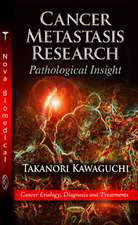The Merkel Cell: Structure-Development-Function-Cancerogenesis
Editat de Klaus Baumann, Zdenek Halata, Ingrid Mollen Limba Engleză Hardback – 22 iun 2003
Essential aspects of structure, development and function of normal Merkel cells and Merkel cell carcinoma are presented in short chapters, providing concise and up-to date information on this fascinating cell type.
| Toate formatele și edițiile | Preț | Express |
|---|---|---|
| Paperback (1) | 977.87 lei 38-44 zile | |
| Springer Berlin, Heidelberg – 29 noi 2010 | 977.87 lei 38-44 zile | |
| Hardback (1) | 1101.21 lei 43-57 zile | |
| Springer Berlin, Heidelberg – 22 iun 2003 | 1101.21 lei 43-57 zile |
Preț: 1101.21 lei
Preț vechi: 1159.17 lei
-5% Nou
Puncte Express: 1652
Preț estimativ în valută:
210.71€ • 220.59$ • 174.35£
210.71€ • 220.59$ • 174.35£
Carte tipărită la comandă
Livrare economică 07-21 aprilie
Preluare comenzi: 021 569.72.76
Specificații
ISBN-13: 9783540003748
ISBN-10: 3540003746
Pagini: 264
Ilustrații: XIV, 248 p. 193 illus., 61 illus. in color.
Dimensiuni: 155 x 235 x 20 mm
Greutate: 0.59 kg
Ediția:2003
Editura: Springer Berlin, Heidelberg
Colecția Springer
Locul publicării:Berlin, Heidelberg, Germany
ISBN-10: 3540003746
Pagini: 264
Ilustrații: XIV, 248 p. 193 illus., 61 illus. in color.
Dimensiuni: 155 x 235 x 20 mm
Greutate: 0.59 kg
Ediția:2003
Editura: Springer Berlin, Heidelberg
Colecția Springer
Locul publicării:Berlin, Heidelberg, Germany
Public țintă
ResearchDescriere
Since their first description in 1875, Merkel cells have remained an elusive cell type. Their origin as well as their classification as mechanoreceptors have been a matter of controversy and intense discussion. The peptidergic granules in these cells are suggestive of neuroendocrine functions, but their discovery has raised additional questions regarding Merkel cell function.
Essential aspects of structure, development and function of normal Merkel cells and Merkel cell carcinoma are presented in short chapters, providing concise and up-to date information on this fascinating cell type.
Essential aspects of structure, development and function of normal Merkel cells and Merkel cell carcinoma are presented in short chapters, providing concise and up-to date information on this fascinating cell type.
Cuprins
From the contents: Merkel cells as mechanoreceptors in vertebrates.- 3D-microanatomy of Merkel cells.- FM dye staining of living Merkel cells.- Distribution of Merkel cells in normal skin and mucosae in dogs.- Merkel cells in transplanted flaps.- The sensory system of peri-implant tissue - behavior of Merkel cells and nerve fibres.- Merkel cell nerve endings in sinus hairs of young and aged rats.- Immunohistochemical characterization of normal canine Merkel cells.- Merkel cells in the human fetal and adult esophagus.- Possible functional significance of spatial relationship between Merkel cells and Langerhans cells in human hair follicles.- Mammalian Merkel cells as neural crest derivatives.- Dissociation and quantification of normal human Merkel cells.- Confocal microscopic analysis of full Merkel cell innervation in cat mystacial vibrissa follicles.- Voltage dependent Ca-channels in Merkel cells of hamster oral mucosa.- Localization of signal transduction proteins in the Merkel cell axon complex.- Possible glutamate receptor involvment in transmission at the Merkel cell - nerve terminal junction ?.- Transduction in Merkel cell mechanoreceptors.- Merkel cell carcinoma – A short review.- Glycoconjugates in Merkel cell carcinomas.- Two distinct subtypes of Merkel cell carcinoma.- Developmentally regulated transcription factors in Merkel cell carcinoma.- Expression patterns of connexins in Merkel cell carcinoma and adjacent epidermis.- Expression patterns of tight junction proteins in Merkel cell carcinoma.- Ganglioside profiles of Merkel cell carcinoma.- MOC-31, S-100 protein and cytokeratin 7 immunoreactivity in Merkel cell and Merkel cell carcinoma.- Merkel cell carcinomas possess telomerase activity.- Chemotherapy in Merkel cell carcinoma with distant metastasis – proposal of a pan-European clinical trial.
Textul de pe ultima copertă
Since their first description in 1875, Merkel cells have remained an elusive cell type. Their origin as well as their classification as mechanoreceptors have been a matter of controversy and intense discussion. The peptidergic granules in these cells are suggestive of neuroendocrine functions, but their discovery has raised additional questions regarding Merkel cell function.
Essential aspects of structure, development and function of normal Merkel cells and Merkel cell carcinoma are presented in short chapters, providing concise and up-to date information on this fascinating cell type.
Essential aspects of structure, development and function of normal Merkel cells and Merkel cell carcinoma are presented in short chapters, providing concise and up-to date information on this fascinating cell type.
Caracteristici
Summarizes the present state of research on Merkel cells in the areas of anatomy, development, function and specific characteristics of Merkel cell carcinoma
Includes supplementary material: sn.pub/extras
Includes supplementary material: sn.pub/extras










